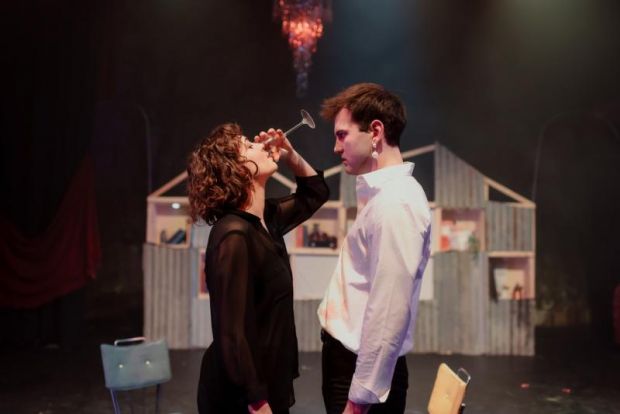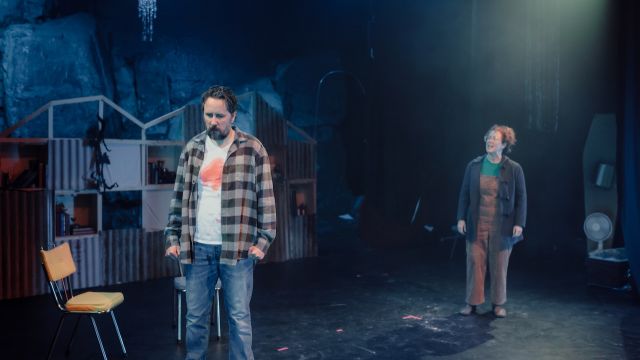Nosferatu
Nosferatu is a bit hard to explain. Originally it was a 1922 German film, a thinly veiled adaptation of Dracula. Few copies of this influential film exist today because the estate of Bram Stoker sued the production company and had the copies destroyed.
Keziah Warner adapted this story under commission from the Malthouse theatre and was subsequently awarded Highly Commended in the Victorian Premier’s Literary Awards of 2024.
Knowing this, Nosferatu, is still difficult to explain. Nosferatu is set in Tasmania. Bad Company Theatre are thus premiering the work in the state in which Warner chose for it to be set. Bluewater is a small town in decline, ravaged by the effects of mining and desperate to reinvent itself. This very familiar Tasmanian story is married to the very familiar story of Dracula. Count Orlock is both the old-moneyed aristocrat of sensual and deviant habits as written by Bram Stoker, and the Tasmanian nightmare which is the gender fluid, venture capitalist and wine loving mainlander looking for a sea change. Quirky locals in a quirky town where horrors bubble to the surface is reminiscent of the recent productions of ABC’s Bay of Fires or Prime’s Deadloch.
It is inevitable that the coalescence of comedy, contemporary themes and classic literature should result in a clash in register and tone. This is navigated with no unevenness in the performance or direction.
Bil Heit takes the character Kate, a character who is always played ‘straight’. Newly returned to the town as the local GP, Kate is the observer and commentator on the action and the one character not inveigled by Orlock. Heit’s calm presence adds verisimilitude to the puppetry used. Heit is secure and credible in this pivotal part.
Paul Dellas takes the challenging role of Tom. Likeable, innocent and optimistic, Tom becomes a different person under Orlock’s influence. Dellas navigates this adeptly. Tom is physically transformed, confused, and conflicted. Dellas plays the comedy inherent in the role but is also elicits anxiety for Tom’s fate. The vagaries of tone are traversed easily by Dellas.
The same can be said of Milla Chaffer as Ellen. Chaffer makes Ellen alluring but also down to earth, unable to understand what has happened to Tom. Under Orlock’s influence, Chaffer gives another aspect of Ellen; confident and sensual. In all the stylistic transitions there is still verisimilitude in her performance.

Knock, played by Andrew Holmes, is seduced by Orlock in a different way. As mayor of the town, and love interest for Kate, Knock is a sympathetic real-world character who becomes something quite different. Holmes is an excellent comedic talent. His act two monologue in the company of Orlock is an acting turn of note.
All must traverse the tonal shifts between naturalist and stylised performance. This peaks with the beautifully choreographed dinner party which all characters attend. The centrepiece of the scene is a marvellous stage property, and the filmic ballet of the actors culminates in a piece of stage magic which induces gasps from the audience. Good direction is often invisible but, in this instance, the direction is notable and praiseworthy.
Will Norris takes the role of Orlock. This young actor is well cast and has been directed into extending his range in this wonderful role. Norris manages to be both attractive and repulsive, frightening and funny. He physicalises the role very well. Orlock is often camp, moving in a slow and deliberate manner. This makes one significant moment of spider-like attack even more astonishing. Norris has the privilege of perpetrating several moments of stage magic which leave the audience gasping.
The set works well to incorporate the gothic (swags of curtain and a prominent chandelier), and the prosaic (the corrugated iron of the mining town). The set is functional in that there are cubby holes for properties. These are used to indicate the location of scenes such as the doctor’s surgery or Tom and Ellen’s home. The set also includes a screen for shadow puppetry. Red is the default colour of choice in a lighting plot which is darkly foreboding and thickly painted on a canvas of fog. Green is used for toxicity, blue for the chemically destroyed blue lake.
Finn Carter’s sound design is excellent. In the manner of the silent film from which Nosferatu originated, scene transitions are punctuated by tense motifs. Extended soundscapes evocative of dripping dungeons and chains upon flagstones raise the tension is scarier scenes. An accelerating heartbeat is a constant reminder of pumping blood.
Nosferatu is still difficult to explain. It is a mishmash of styles that is navigated beautifully by the actors. It is funny and frightening. It is magical and mysterious. It is very well directed and brings together all the right creative elements. Nosferatu an elusive beast, difficult to categorise, but very wroth while seeing.
Anne Blythe-Cooper
Images: Millie Crouch Photography
Subscribe to our E-Newsletter, buy our latest print edition or find a Performing Arts book at Book Nook.

